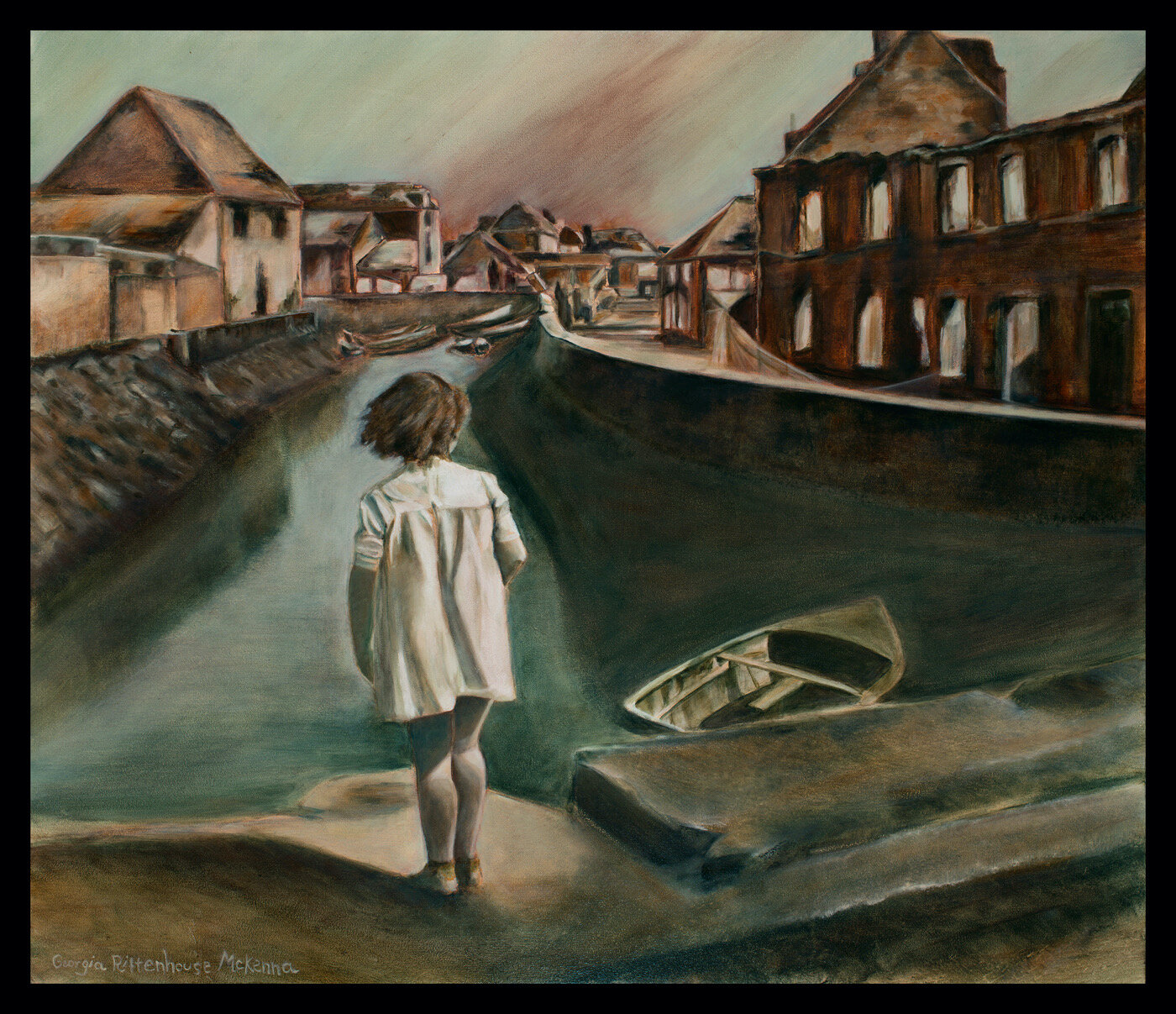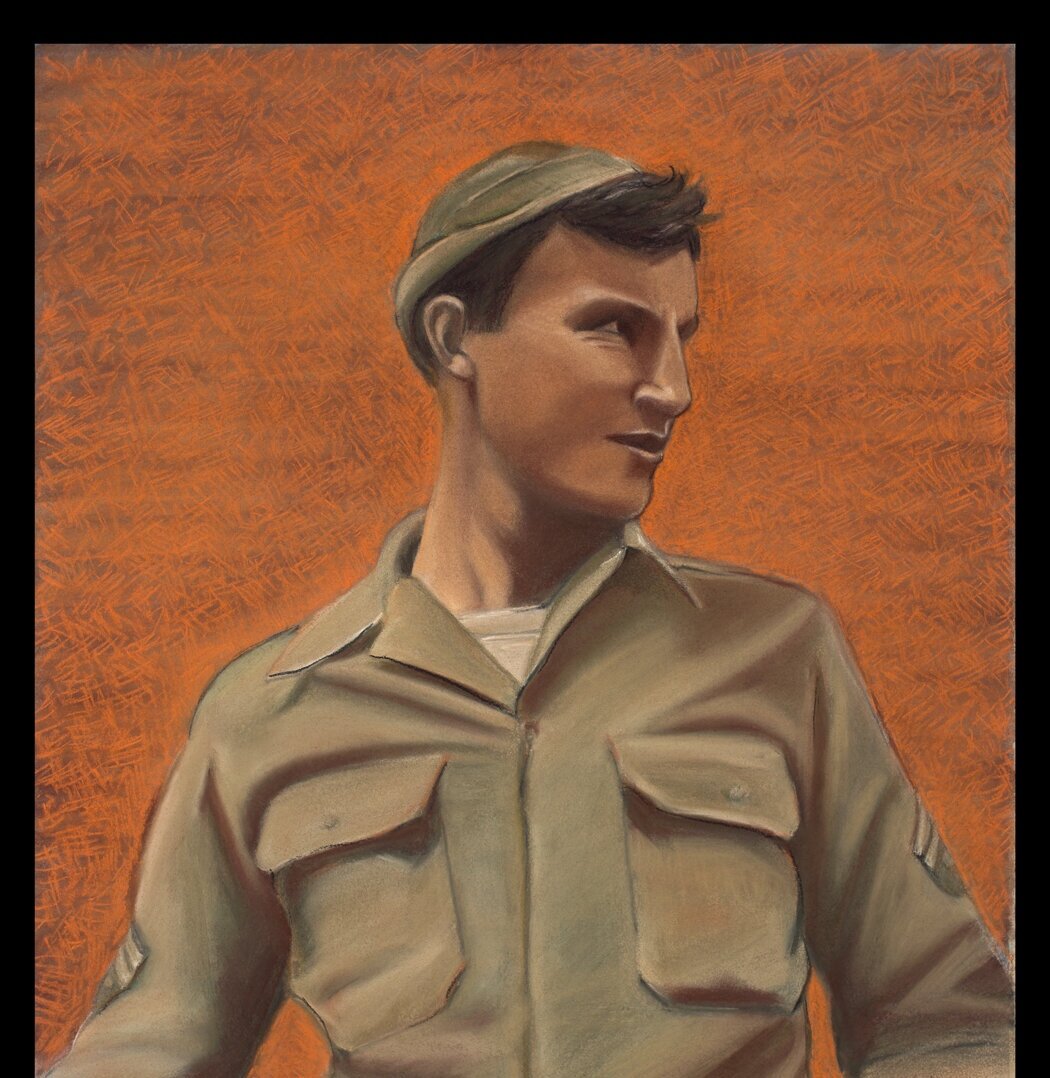Ghost Army Paintings: World War II
The paintings in the Ghost Army series are interpretations, inspired by the tiny original black and white contact prints my father, 1st Lieutenant George Virgil Rittenhouse, brought back from his service during World War II.
Less than 80 years ago — a single lifetime — the world was engulfed in war. These paintings explore the grim reality of combat punctuated with interludes of exhaustion, bewilderment, loneliness and, sometimes, human kindness.
Click on any image to see it in its entirety.
"Sgt. Kent" Normandy, France, 1944. 18 x 24 inches, pastel, oil on panel.
Staff Sergeant Kent’s jacket hangs on a pole, revealing his rank. The pole is anchored by a wooden shoe. I was fascinated by the abstract quality of the strongly contrasting shadow of the boot and leg and the way his head disappears into the shadow of the tent. His helmet lies in the foreground.
What do we see in his posture and outward gaze? What is his state of mind? The red towel hangs like the cloth a toreador waves to enrage a bull.
The sergeant welcomes a break to rest, but at this moment he is alert. The unit is still in Normandy, not long after the D-Day invasion that would eventually liberate France and the rest of Europe. Many battles lie ahead for Sergeant Kent before his war will end.
“What we did was highly classified. Even the American Army didn’t know about us — only General Eisenhower and a few others. We specialized in impersonating other troops in order to fool the enemy. We had to make the Germans think the American troops were in one place when in fact they were somewhere else.”
George Virgil Rittenhouse, 1st Lieutenant & Platoon Commander, 603rd Camouflage Battalion
"St. Germain-en-Laye", September 1944, Near Paris. 18 x 23 inches, pastel, charcoal, pencil on paper.
Paris was liberated by the Allied Forces on August 25, 1944. This scene, which took place near Paris only a few weeks later, reminds us how quickly the human spirit can regenerate itself.
This work, in pencil, pastel and charcoal on paper, is the only black and white in the Ghost Army series. The people and some of the compositional elements still fascinate me. Look at the rhythm of the receding chairs and the abstract patterns of table and chair legs. Not one person is smiling. Everyone seems uneasy. One woman in the center of the scene is alarmed, perhaps startled or afraid, or simply on edge. Who is the little boy with? Is that his father on the far right? Notice the man and woman in the foreground. The man has turned toward her warmly. Holding his pipe aside, he speaks to her. But she continues looking away from him with almost hostile indifference. There is an American GI center to the right — on leave? Perhaps from the brothel in St. Germain at the time, a gaggle of beautiful young women are clustered nearby, talking madly among themselves, all with amazing hairdos. There is a Frenchman in a beret, and behind him the mysterious silhouette of a man in a hat. The waiter balances drinks on a tilting tray. The war in France continues.
"Platoon, Belgium" Company in Woods. 24 x 28 inches, pastel, oil on panel
What does a man's posture and stance tell me? A lot. As I painted these men, I developed a strong sense of who each of them was. Dad faces into the group, but he is apart from it. The lieutenant operates by the book. He takes charge, assumes responsibility. The only soldier turned toward my dad is Staff Sergeant Kent.
At the center is Staff Sergeant Stanley Wright. Calm and steady, he rests his hands on one soldier, while another two lean in toward him.
The soldiers holding rifles are very different. One is loosely casual; the other plants his feet firmly on the ground and wears a tough expression. The soldier squatting near Sgt Kent's feet is holding some sort of pump -- this camouflage platoon was undoubtedly on a mission.
"Normandy" Bombed Bridge. 20 x 42 inches, pastel, oil on panel.
Life finds a way to go on. War, for this moment at least, recedes into the background. Ferrymen carry people and their bicycles across the water and back. The remnants of a ruined bridge litter the waterway. Bombs explode in the distance.
“One of my buddies, Sebastian Messina, told a newspaper reporter later, ‘The Germans were tearing their hair out trying to determine which part of a campaign was real and which was fake. They never caught on to us, never found out we existed, because we were always someone else.’”
Ed Biow, Private First Class
"Montmartre" Paris, September 1944. 30 x 24 inches oil on panel. After the liberation of Paris, the city flickers back to life.
"Near Stratford-upon-Avon" 20 x 20 inches, oil on canvas. The 23rd Headquarters Special Troops arrived in England in May, 1944 and prepared for the Normandy Invasion. Fishing boats on the beach cast dark shadows like graves.
"Brittany" France. 20 x 16 inches, pastel, oil on panel. Together the farmer and his daughter harvest hay. With her red dress and sharp pitchfork, she is strong and tall and formidable.
"Near Torcé" France. 16 x 20 inches, pastel, oil on canvas. The 23rd Headquarters Special Troops "formally liberated" Torcé in a ceremony in late August, 1944. In this haunting image a family watches from a window as an old woman clutches her purse and makes her way to the ceremony.
"Seamstress" 24 x 28 inches, pastel, oil on panel. Light pouring through an open doorway illuminates the hand of the seamstress. Piles of mending await her attention. Shadows are darkly graphic. The starkly silhouetted table and pitcher seem to point toward her as she works.
"Outside of Torcé" France, August 1944. 17 x 28 inches, pastel, oil on panel. After the Liberation of Torcé, the townspeople welcomed the Ghost Army soldiers.
"St. Lo" France. 27 x 23 inches, pastel, oil on panel.
St. Lo was one of the most heavily bombed cities during the war. Had this little girl been orphaned like so many other children? Her hair is disheveled, her sleeves are tight and her dress too short. Q.C. Kipp DeAngelis wrote "In Normandy, an eight-year-old boy lived in my foxhole. He hadn't seen his family since the day of the invasion."
"Mistress with Pierre La Due" Paris, August 1944. 28 x 23 inches, oil on panel. Who exactly was the Frenchman, Pierre La Due? His large clenched fist holds her arm tightly against his immaculate suit. The mistress holds an American helmet, but the soldier next to her has one of his own. Who is the woman poking her head out of the window, watching the scene?
"1st Lieutenant George Virgil Rittenhouse, Displaced Person's Camp" Trier, Germany, April 1945. Dad was twenty-five when the Ghost Army was sent to guard five Displaced Persons Camps in Germany. Thousands of cruelly mistreated people were detained after being "treated like slaves and animals" by the Nazis. The displaced people were confined in camps, to the distress of the Americans, in order to protect the surrounding German villagers from their vengeance.
"Tec 5 Corporal Robert C. Petrucci", 21 x 23 inches, pastel on paper. Bob Petrucci was my father's jeep driver. We met Bob at my father's funeral, and he became a dear family friend. He was warm, generous and funny and a talented and accomplished artist. His daughter Cynthia told me that during his last years he lost his eyesight but continued to "see". Seeming to gaze out his window, he saw the hungry, orphaned children who haunted him for a lifetime since his years in the Ghost Army.













